Caregiving: Skin Care for Immobile Adults
Overview
As we get older, our skin gets thinner and drier, so it is easier to damage. The chance of skin damage is higher for people who can't move much, or who spend most of their time in bed or in a wheelchair. The skin can develop rashes and sores, especially pressure injuries (also called pressure sores). These injuries are caused by constant pressure, which can limit the blood supply to the skin.
Skin also can be damaged by sweat, feces, or urine, making pressure injuries more likely and harder to heal.
You can help protect the skin of the person you're caring for by checking it every day and by being careful when cleaning it.
Checking the skin for problems
Check the person's skin every day. It's easiest to do this when you help the person bathe and dress. Let the person know why you're checking the skin.
Keep their body covered except for the area you are checking. This will help them stay warm and also may help them feel more comfortable.
Look for pressure injuries, especially around bony areas.
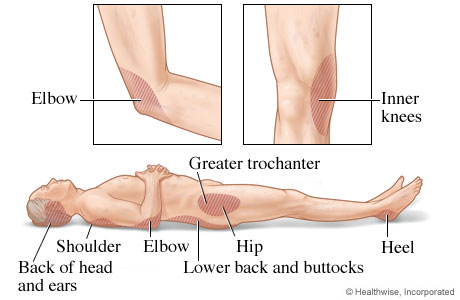
The most common places for pressure injuries are the back of the head and ears, the shoulders, the elbows, the lower back and buttocks, and the hips. Pressure injuries also can form on the inner knees and the heels.
When a pressure injury forms, the skin temperature can be different than nearby skin. It might be warmer or cooler. The skin can also feel either firmer or softer than the rest of the skin.
Check for rashes in skin folds and creases.
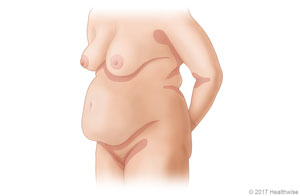
Rashes can develop in folds of skin on the torso, and in the creases of the armpits, elbows, and groin.
Watch for rashes around the knees, ankles, and toes.
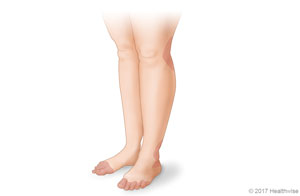
Rashes can develop in the creases around the knees and ankles and in between the toes.
Check for rashes in the groin and anal areas.
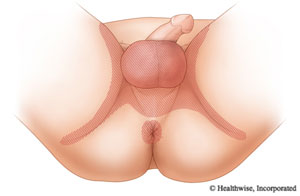
Rashes can also develop around the genitals and anus and in the creases where the legs join the body.
Watch for problems from thinning skin.
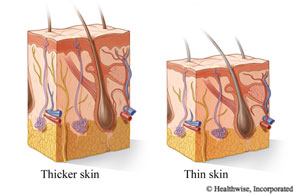
As people get older, the skin gets thinner. It's easier for the skin to tear. This means an increased chance of injury, such as pressure injuries. Older adults also can be more sensitive to cold because of thinner skin.
Preventing pressure injuries
Relieving and spreading out pressure is the most important part of both preventing and treating pressure injuries. Putting pressure on one spot for long periods of time damages the skin and underlying tissues. Pressure can be relieved and spread in several ways. Often a combination of these is best.
- Change position often.
- In a bed, change position every 2 hours. Learn how to move yourself so that you avoid folding and twisting your skin.
- In a wheelchair or other type of chair, shift your weight every 15 minutes.
- Try not to slide or slump across sheets in a chair or bed. Recliner chairs are likely to allow slipping, so don't sleep in a recliner. Try to keep the head of a bed, a recliner chair, or a reclining wheelchair raised no more than 30 degrees.
- Take good care of your skin.
- Bathe as often as needed to be clean and comfortable. Use gentle soap, and use warm (not hot) water. Be careful not to scrub the skin too hard.
- If you have problems with bowel or bladder control, clean your skin right away if it gets soiled or wet. Use a protective barrier cream, lotion, or ointment to protect your skin from wetness. Use pads or briefs that absorb moisture and pull it away from your skin.
- If you have dry skin, use moisturizing cream or lotion to keep your skin from drying out and cracking.
- Check your skin every day for signs of pressure injuries. Pay special attention to bony areas such as the hips, elbows, knees, and heels. Also watch for pressure from sources such as:
- Body parts or skin folds, especially if you're overweight.
- Chair arms, parts of wheelchairs, braces, or other places where you rest your elbows or other body parts.
- Medical equipment such as oxygen masks or oxygen tubing.
- Make healthy choices.
- Eat healthy foods with enough protein, and get plenty of fluids (unless your doctor has told you to limit your fluid intake). That can help damaged skin heal and help new skin grow.
- If you smoke, quit or cut back as much as you can. Talk to your doctor if you need help quitting. Smoking dries the skin and reduces blood supply to the skin.
- Talk to your doctor about pressure-relieving cushions and pads.
- Use special support surfaces. There are mattresses, bed covers, and chair cushions designed to help reduce and spread pressure.
- Ask your doctor which cushions and pads might help you. Some products, such as doughnut-type devices, may actually cause pressure injuries or make them worse.
If you or someone you care for is not able to move much, it's important to prevent pressure injuries and to check the skin every day. If you think that a pressure injury is forming, take steps to treat it. Talk to your doctor or nurse about what more you can do.
What can you do to keep skin healthy?
Keeping the person's skin clean and moisturized can help keep their skin healthy.
- Help them bathe as often as needed to be clean and comfortable. When helping someone bathe:
- Use gentle soap.
- Use warm (not hot) water.
- Wash gently with a washcloth.
- Pat the skin dry rather than rubbing. You also can offer the person a terry cloth robe. Terry cloth is a type of fabric often used for towels. It can help gently dry the skin.
- Use moisturizing creams or lotions to keep the skin soft. If the skin is very dry, use a protective barrier cream, lotion, or ointment. These include over-the-counter lotions such as CeraVe. Some lotions are available by prescription.
- Don't put moisturizers in creases and folds, such as those under the breasts and in the groin or on the stomach. These areas are already moist. More moisture can lead to rashes and infections.
- A humidifier may help prevent dry skin. Make sure to clean the humidifier as directed. This can prevent mold, fungus, or bacteria from forming in the machine.
- Good nutrition and plenty of fluids can also help the skin stay healthy and heal if it's damaged. Provide healthy foods, including protein foods, fruits, and vegetables. Offer the person plenty of water. If the person has kidney, heart, or liver disease and has to limit fluids, talk with their doctor before increasing the amount of fluids.
- When washing clothing and sheets, use mild detergents. Don't use fabric softeners. And try to have the person wear clothing made with soft fabrics, such as cotton (rather than wool).
Related Information
Credits
Current as of: October 25, 2024
Author: Ignite Healthwise, LLC Staff
Clinical Review Board
All Ignite Healthwise, LLC education is reviewed by a team that includes physicians, nurses, advanced practitioners, registered dieticians, and other healthcare professionals.
Current as of: October 25, 2024
Author: Ignite Healthwise, LLC Staff
Clinical Review Board
All Ignite Healthwise, LLC education is reviewed by a team that includes physicians, nurses, advanced practitioners, registered dieticians, and other healthcare professionals.




